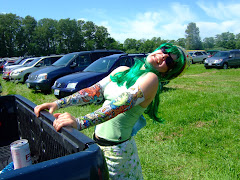 I'm pretty sure I'm going to win the lottery soon, because I keep having these fantasies about improvements I'd like to make to the NapCastle. Before you go all ballistic and "you just built that house TWO YEARS ago!" on me, remember the Anne Frank Room, and recall that it is semi-inhabitable, eagerly awaiting the large influx of cash that will transform it into the Coolest Little Apartment Ever. If there's any chance that you think a 200-square-foot space can't be an entire residence, you need to go two places: 1) http://www.apartmenttherapy.com/ and 2) your local bookstore to purchase the book creater by the authors of the AT blog: Apartment Therapy's Big Book of Small, Cool Spaces.
I'm pretty sure I'm going to win the lottery soon, because I keep having these fantasies about improvements I'd like to make to the NapCastle. Before you go all ballistic and "you just built that house TWO YEARS ago!" on me, remember the Anne Frank Room, and recall that it is semi-inhabitable, eagerly awaiting the large influx of cash that will transform it into the Coolest Little Apartment Ever. If there's any chance that you think a 200-square-foot space can't be an entire residence, you need to go two places: 1) http://www.apartmenttherapy.com/ and 2) your local bookstore to purchase the book creater by the authors of the AT blog: Apartment Therapy's Big Book of Small, Cool Spaces. squelched my obsession with homes--it's amplified it. Now that I have a house, I want to learn all about houses. I want to look at pictures of houses and decor and color schemes and weird ways to create art out of recycled stuff (see photos of poems I painted and strapped to the side of the NapCastle) and hidden spaces and beds that pop out of walls (front porch Murphy bunk, anyone?).
squelched my obsession with homes--it's amplified it. Now that I have a house, I want to learn all about houses. I want to look at pictures of houses and decor and color schemes and weird ways to create art out of recycled stuff (see photos of poems I painted and strapped to the side of the NapCastle) and hidden spaces and beds that pop out of walls (front porch Murphy bunk, anyone?).  I recently listened to Bill Bryson read his latest book, At Home, in which he uses his own centuries-old English parsonageas a framework for exploring the history of human domesticity.
I recently listened to Bill Bryson read his latest book, At Home, in which he uses his own centuries-old English parsonageas a framework for exploring the history of human domesticity. Meghan Daum's book about seeking and purchasing her first house, Life Would Be Perfect if I Lived in that House. Daum's search for a home coincides with her realization that she might not marry and have a husband, children, and a "traditional" life--all things I can relate to, which may be why her quest and subsequent success made me a little sad as I read. Nevertheless, I could relate to and appreciate her obsession with space. Like me, she has longed dreamed of a home of her own, and how that house will contribute to her definition of herself. Her insight into how space shapes self is intelligent and entertaining.
Meghan Daum's book about seeking and purchasing her first house, Life Would Be Perfect if I Lived in that House. Daum's search for a home coincides with her realization that she might not marry and have a husband, children, and a "traditional" life--all things I can relate to, which may be why her quest and subsequent success made me a little sad as I read. Nevertheless, I could relate to and appreciate her obsession with space. Like me, she has longed dreamed of a home of her own, and how that house will contribute to her definition of herself. Her insight into how space shapes self is intelligent and entertaining.Because I do connect my space so intimately with my sense of self, I am always making mental ammendments to the NapCastle. I move artwork and rearrange furniture to match my moods and whims. I dream of additions where I can house more roommates, and outdoor patios where the sun shines EVERY DAY. It's not about having more stuff, or better stuff, or a bigger house--for me, it's about making the house I have even homier. I have THAT house, and life isn't perfect. But it's pretty amazing.

 It's possibly my imagination at work, but it seems as though whenever I go on a trip, I hear 80's music the whole time--in Puerto Vallarta, in stores and hotel lobbies in San Francisco, and most recently, during my stay at L'Auberge in Del Mar. Everytime we went to the pool, it was like traveling through a time tunnel, except for the part where I'm wearing a size 5 bikini and slathering my skin with baby oil.
It's possibly my imagination at work, but it seems as though whenever I go on a trip, I hear 80's music the whole time--in Puerto Vallarta, in stores and hotel lobbies in San Francisco, and most recently, during my stay at L'Auberge in Del Mar. Everytime we went to the pool, it was like traveling through a time tunnel, except for the part where I'm wearing a size 5 bikini and slathering my skin with baby oil. 








